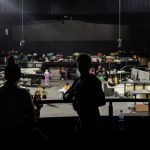Synthetic fuels offer hope for climate-friendly flying. For the first time, the German Aerospace Center measured the emissions produced during test flights.
It looks like a scene from the Hollywood action film “Top Gun”: A plane slowly approaches the plane in front, descends and then cuts in directly behind it. The plane begins to shake violently and the instruments in the cockpit rattle. Only 50 meters separate the two machines.
The two pilots in the cockpit control the Falcon 20E confidently and with concentration in the turbulence – but in fact only the best can complete this maneuver: flying directly into the exhaust jet of a machine flying in front. “It's like a very dynamic whitewater rafting trip where you always have a jackhammer with you,” describes Ingmar Mayerbuch, one of the pilots and head of flight operations at the German Aerospace Center in Oberpfaffenhofen (DLR).
Damage to the climate should be limited
The DLR has achieved something that no one has done before: it was able to measure in flight what emissions a turboprop aircraft produces when it flies with 100 percent synthetic fuel. The first emission measurements had already taken place at Oberpfaffenhofen Airport a few months ago – albeit on the ground.
Now the e-fuelled “D328 UpLift” took to the air for the first time together with the DLR laboratory aircraft. The scientists want to find out to what extent the use of e-fuels can contribute to reducing climate-damaging emissions in aviation.
Direct and indirect CO2 effects
The rough ride is intended to be a step on the way to an ambitious goal: The EU has decided to achieve climate neutrality in the economy and society by 2050. This also applies to air traffic. According to a report by the Office for Technology Assessment at the German Bundestag (TAB), aviation contributes 3.5 to 5 percent to global warming. “Aviation will have to reinvent itself,” says Markus Fischer, DLR Head of Aviation.
Flying is a climate problem in two respects: on the one hand, air traffic directly produces the greenhouse gas CO2, but on the other hand there are also so-called non-CO2 effects. This includes, above all, the formation of contrails. “Condensation trails warm to a similar extent to the total CO2 since the beginning of aviation,” explains scientific project manager Christiane Vogt from the DLR Institute of Atmospheric Physics. Contrails form because ice crystals form on the soot from the exhaust gases. They grow into ice clouds and reflect the earth's heat back onto the surface.
Fewer Contrails
The TAB report already pointed out that synthetic kerosene (“Power to Liquid”, PtL), which is produced with electricity from renewable energies as well as CO2 and water, can make a contribution towards climate-friendly flying: Since the e- Fuels can be burned with almost no soot particles, and fewer contrails are formed.
In addition, they are ready for immediate use as so-called “drop-in fuel”, says DLR flight operations manager Ingmar Mayerbuch: “The nice thing is that you actually don't notice a big difference. The performance is the same, the dynamic behavior of the engine is the same.” Only the seals would have to be adjusted because the synthetic kerosene reacts differently with the material than conventional fuel.
However, Nora Wissner, climate scientist at the Berlin Öko-Institut, points out that there is currently a lack of production capacity for the new fuels. “In 2030, the announced production facilities will reach almost 1.4 million tons. Only a third of this production capacity will be created in Europe, and that corresponds to just three percent of the current fuel use in the EU for aviation.” After all: on October 1st, construction of the world's largest research facility for e-fuels began in Leuna with the symbolic groundbreaking ceremony.
E-fuel is only part of the solution
Furthermore: E-fuels can only be part of the solution to making flying more climate-friendly. The researchers in the DLR project also point this out. Since contrails only appear under certain weather conditions, flight routes would have to be better planned in the future.
The DLR experts also see a need for improvements in the aircraft's propulsion systems and the aircraft design itself.




